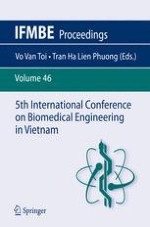
2015 | OriginalPaper | Buchkapitel
Development of Individual Plasmonic Nanosensors for Clinical Diagnosis
verfasst von : Phuoc Long Truong, Sang Jun Sim
Erschienen in: 5th International Conference on Biomedical Engineering in Vietnam
Aktivieren Sie unsere intelligente Suche, um passende Fachinhalte oder Patente zu finden.
Wählen Sie Textabschnitte aus um mit Künstlicher Intelligenz passenden Patente zu finden. powered by
Markieren Sie Textabschnitte, um KI-gestützt weitere passende Inhalte zu finden. powered by
Accurate detection of panels of protein biomarkers in serum, saliva, or tissue plays an important role in early detection of diseases. Recently, our lab has developed the localized surface plasmon resonance (LSPR)-based immunosensors with highly promising analytical approach for qualification and quantification of biochemical substances in various applications. The LSPR of noble nanoparticles shifts upon refractive index changes of the dielectric environment surrounding the nanoparticles, subsequently causing a peak shift of the LSPR; it is also very sensitive to the binding events near the nanoparticle surface. Therefore, individual nanoparticles are sufficiently sensitive to detect the molecular interactions on the nanoparticle surface induced by biological molecules at ultralow concentrations. Furthermore, LSPR
λ
max shifts induced by adsorbates on the nanoparticle surface are completely linear with the number of bound molecules. Owing to this reason, each nanoparticle can be used as an independent sensor. By functionalizing the nanoparticle surface with the appropriate receptors, individual nanoparticle sensors can be used as diagnostic tools for a variety of diseases. Herein, we introduce the resonant Rayleigh scattering properties of single Au nanoparticles and the use of single Au nanoparticles as the plasmonic transducers to detect the binding of protein biomarkers to specific receptors conjugated gold nanoparticles. The principle of detection based on the resonant Rayleigh scattering response of single Au nanoparticles and the LSPR
λ
max shift of resonant Rayleigh scattering spectrum. This approach holds great promise as a simple, label-free, ultrasensitive method for detection of protein biomarkers in clinical diagnostics.